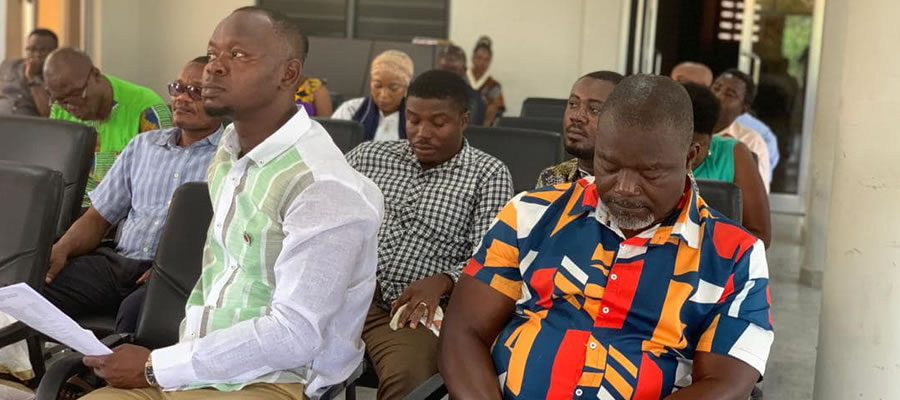

Agriculture is the major economic activity in Agona and engages more than 64% of the population. The high soil fertility supports cultivation of tree/cash crops, food crops, vegetables and sugarcane. Tree crops such as cocoa, citrus, oil palm and cola are cultivated. Food crops like maize, cassava cocoyam and vegetables are also cultivated and the District supplies Kasoa, Bawjiase and Accra markets.
Crop yields are low, the major contributing factors being outmoded agricultural practices, declining soil fertility, small farm holdings, use of very simple technology and dependence on the weather. This notwithstanding, Agona still has enormous potential to increase overall output because agricultural practice is still not intensive enough and about 20% of arable land still remains uncultivated. The demand and supply situation of some major food crops, for example cassava, maize, plantain, coconut and citrus indicate that the has a surplus of production which is exported to destinations outside the muncipality.
Agricultural technology in the is mainly traditional and subsistence, employing farming implements like hoes, cutlasses and axes and this partly explains the low productivity. Though a considerable number of farmers use improved seed varieties and agro-chemicals, these have not made a significant impact on production because farmers lack the capital to enable them use these inputs on a sustainable basis. Though there are no irrigation schemes in Agona, farmers in Asafo and Kwanyarko sub-district areas engage in dry-season vegetable cultivation making use of rivers and streams by fetching water direct from these water bodies through manual means. The use of hired farm labour is important during peak farming periods for land preparation and weeding. Farmers use own or family or hired labour for these tasks.
Modern Storage systems are virtually non-existent. Traditional barns and improved cribs are however employed to store maize. Solar drying methods have been applied on a limited scale for cocoa and recently, pepper. The absence of storage and preservation facilities compels farmers to sell their produce especially vegetables at low prices during the bumper harvest periods. For the same reason also, the annual average post-harvest loss for maize is almost 30% and higher losses have been recorded for vegetables. Traders from Accra, Tema and Mankessim buy these produce at farm gate and the marketing centres. Though there are 11 markets fairly distributed over the District, the greater volume of trade takes place at Swedru and Nsuansa with the latter handling a large volume of raw farm produce.
Financing of farming activities is mainly through farmers’ own savings. Informal lending from members and moneylenders are also patronized. Though the interest charged is very high in most cases (between 50% and 100%), the unavailability of formal credit facilities. - compel some farmers to resort to this source of finance. The District Agriculture Development Unit (DADU) is constrained especially by shortage of staff and logistics and is unable to provide the required level of extension services to farmers. In the absence of farmers associations or cooperatives, farmers are unable to present a common front to raise credits and to protect their own interests. Pepper Growers Associations exists for the purpose of producing the commodity for export. Non-traditional export crops currently produced in Agona District are citronella, black pepper, and pineapples. Though no statistics currently exist on production levels. The District has a great potential for its development.
Though there are no forest reserves in the municipality, Agona lies in the forest zone of the Central Region. Some 10% of its landmass is under forest. Most of the existing forest in the District is secondary and containjspecies like odum, wawa and mahogany. The major forest products of commercial value include timber, firewood, charcoal and wooden poles which are processed and sold. The few existing sawmills are located in Swedru. The forest resources have not been sustainably exploited for the economic prosperity of the populace.
Commercial Livestock production is on a limited scale. Apart from a few cattle and poultry kept on the outskirts of the major towns, all other animal rearing activities are for domestic consumption only. Fishing is done along the Akora and Ayensu rivers. This is economically insignificant. Aquaculture is almost unknown. Trade and commerce is the second most important economic activity throughout the District. It is the main stay of the people of Swedru. To boost trade and commerce the first medium term plan undertook an ambitious programme of market infrastructure construction and rehabilitation.
Out of the eleven market structures slated for construction/ rehabilitation. Seven were either completed or on going.. This is almost 64% performance and obviously sets the pace for increased economic activity in the current plan period. Agriculture is the major economic activity in Agona and engages more than 64% of the District population. The high soil fertility supports cultivation of tree/cash crops, food crops, vegetables and sugarcane. Tree crops such as cocoa, citrus, oil palm and cola are cultivated. Food crops like maize, cassava cocoyam and vegetables are also cultivated and the District supplies Kasoa, Bawjiase and Accra markets.
Crop yields are low, the major contributing factors being outmoded agricultural practices, declining soil fertility, small farm holdings, use of very simple technology and dependence on the weather. This notwithstanding, Agona still has enormous potential to increase overall output because agricultural practice is still not intensive enough and about 20% of arable land still remains uncultivated. The demand and supply situation of some major food crops, for example cassava, maize, plantain, coconut and citrus indicate that the District has a surplus of production which is exported to destinations outside the District.
Agricultural technology in the District is mainly traditional and subsistence, employing farming implements like hoes, cutlasses and axes and this partly explains the low productivity. Though a considerable number of farmers use improved seed varieties and agro-chemicals, these have not made a significant impact on production because farmers lack the capital to enable them use these inputs on a sustainable basis. Though there are no irrigation schemes in Agona, farmers in Asafo and Kwanyarko sub-district areas engage in dry-season vegetable cultivation making use of rivers and streams by fetching water direct from these water bodies through manual means. The use of hired farm labour is important during peak farming periods for land preparation and weeding. Farmers use own or family or hired labour for these tasks.
Modern Storage systems are virtually non-existent. Traditional barns and improved cribs are however employed to store maize. Solar drying methods have been applied on a limited scale for cocoa and recently, pepper. The absence of storage and preservation facilities compels farmers to sell their produce especially vegetables at low prices during the bumper harvest periods. For the same reason also, the annual average post-harvest loss for maize is almost 30% and higher losses have been recorded for vegetables. Traders from Accra, Tema and Mankessim buy these produce at farm gate and the marketing centres. Though there are 11 markets fairly distributed over the District, the greater volume of trade takes place at Swedru and Nsuansa with the latter handling a large volume of raw farm produce.
Financing of farming activities is mainly through farmers’ own savings. Informal lending from members and moneylenders are also patronized. Though the interest charged is very high in most cases (between 50% and 100%), the unavailability of formal credit facilities. - compel some farmers to resort to this source of finance. The District Agriculture Development Unit (DADU) is constrained especially by shortage of staff and logistics and is unable to provide the required level of extension services to farmers. In the absence of farmers associations or cooperatives, farmers are unable to present a common front to raise credits and to protect their own interests. Pepper Growers Associations exists for the purpose of producing the commodity for export.
Non-traditional export crops currently produced in Agona District are citronella, black pepper, and pineapples. Though no statistics currently exist on production levels. The District has a great potential for its development.Though there are no forest reserves in the District, Agona lies in the forest zone of the Central Region. Some 10% of its landmass is under forest. Most of the existing forest in the District is secondary and contain species like odum, wawa and mahogany. The major forest products of commercial value include timber, firewood, charcoal and wooden poles which are processed and sold. The few existing sawmills are located in Swedru. The forest resources have not been sustainably exploited for the economic prosperity of the populace.
Commercial Livestock production is on a limited scale. Apart from a few cattle and poultry kept on the outskirts of the major towns, all other animal rearing activities are for domestic consumption only. Fishing is done along the Akora and Ayensu rivers. This is economically insignificant. Aquaculture is almost unknown. Trade and commerce is the second most important economic activity throughout the District. It is the main stay of the people of Swedru.
To boost trade and commerce the first medium term plan undertook an ambitious programme of market infrastructure construction and rehabilitation. Out of the eleven market structures slated for construction/ rehabilitation. Seven were either completed or on going.. This is almost 64% performance and obviously sets the pace for increased economic activity in the current plan period.
Date Created : 11/13/2017 6:29:18 AM












 facebook
facebook
 twitter
twitter
 Youtube
Youtube
 +233 593 831 280
+233 593 831 280 0800 430 430
0800 430 430 GPS: GE-231-4383
GPS: GE-231-4383 info@ghanadistricts.com
info@ghanadistricts.com Box GP1044, Accra, Ghana
Box GP1044, Accra, Ghana